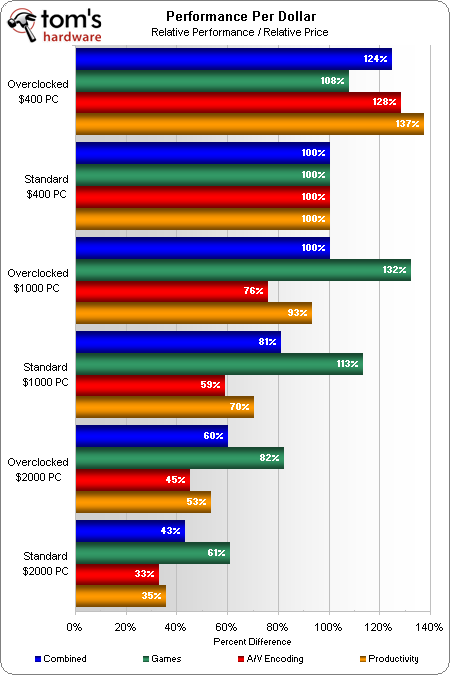System Builder Marathon, Sept. 2010: Value Compared
Value Conclusion
The big questions for today’s system value comparison were whether the cheapest system could perform at minimally-acceptable levels, and whether the most expensive system’s low-cost six-core processor would beat the mid-priced system’s quad-core chip.
While widely-varied results prevent us from drawing broad conclusions, we can at least see that the $400 system completed every task. Built-in patience training is a feature, not a flaw.
Games further defined “acceptability” for the cheapest system, since it obviously wasn’t designed to support high resolutions and high details simultaneously. Half of our games played so slowly at 1280x1024 that we’re inclined to recommend 720p instead. Lower detail settings are another option you can use to increase frame rates, but many users would rather look at a slightly-pixelated image than one that lacks detail. Most of us could probably live with the $400 PC if money were extremely tight.
With the cheapest PC judged “barely acceptable,” let’s see how the others stand up to its value.
Overclocking adds 24% to the $400 system’s value, but it also brings the $1000 system up to 91% of the cheaper-rival’s base value. As fans of both efficiency and performance, our choice would probably be the mid-priced PC, despite the lower-cost build’s value lead.
Handicapped by its CPU in most games and several applications, our $2000 system falls to the bottom of the value chart. Though the Phenom II X6 doesn’t offer enough performance to justify the system’s costly graphics array, it does provide a big performance boost in the few applications that are designed to exploit threading. Thus, anyone whose applications benefit from this particular processor will find far better value using lower-priced graphics, and anyone who really wants to spend $2000 on a “do-everything” PC should pair that less expensive graphics card with a more powerful CPU.
Get Tom's Hardware's best news and in-depth reviews, straight to your inbox.
-
karma831 oops double post...Reply
Anyways, I didn't really like the builds this SBM but I learned quite a bit. Thanks for the great read. -
Yeah the $2000 system did not make much sense. Only spending 10% of your build money on the CPU seems wrong. The two GTX480s and Nvidia mobo was bizarre. I guess they felt they had to throw the AMD CPU guys a bone. The lack of a solid state drive in a $2000 build was also odd to me. Which could be explained if your going after raw gaming power, where they did with the dual 480s, but then they gimped it with that AMD cpu. Why pair dual GTX 480s with a Phenom Hexacore; which are subpar for anything that uses 4 threads or less. For the same $2000, I think you would get a much better system with a core i7 950, 6gb of ddr3 1600, a 120gb SSD, and 2 GTX 460 1gb.Reply
-
HibyPrime I usually skip over the power and efficiency pages of the high-end SBM build, because the power usage is mostly irrelevant for such a high-end build... but when I saw it in the efficiency comparison...Reply
ONE KILOWATT? seriously!? -
Crashman stm1185For the same $2000, I think you would get a much better system with a core i7 950, 6gb of ddr3 1600, a 120gb SSD, and 2 GTX 460 1gb.-1 for the SSD comments since these have always hurt the system's overall score in the benchmark-based value analysis.Reply
-
avatar_raq One of the odd things encountered in the $2000 build is the results of Dirt2. This game bears the AMD logo, and in one benchmark the intel system scored almost double!! OMG!! AMD guys really need to do something about their CPUs and their relations to game developers.Reply -
Crashman MayPSLI does not seems to work in AMD system or it is throttling.The CPU is throttling the rest of the system. Most of the benchmarks show a CPU-capped pattern.Reply -
"The CPU is throttling the rest of the system. Most of the benchmarks show a CPU-capped pattern."Reply
There is noway i5 can be twice as fast as x6. Simply no way. Something is wrong. Unless there is an artificial limitation in the SLI board to prevent it running faster than that. Even 5670 is closer to SLI 480. Simply Dirt2 benchmark is wrong. And I sense SLI is not working. Better to try with Cross Fire setup. -
avatar_raq TheCapulet it's just plain unbelievable that the builder didn't do his homework. If you read the article thoroughly you would know the reasons behind the CPU choice! And Thomas was honest about the results and he clearly said 'we failed'. Besides it IS nice to see someone try that and inform us so that we don't repeat the same, or similar, mistakes!Reply
TheCapulet This will be the first month that people sign up hoping to win the 1k machine instead of the 2k.Free is always good! For me, I wish I win the $2000 build, simply because the 2 gfx cards alone worth almost as the mid-priced build ($920 vs $1000)!


